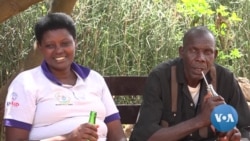Twenty-five years have passed since the Rwandan genocide that claimed the lives of an estimated 800,000 ethnic Tutsis and moderate Hutus. As part of the long journey to reconciliation, an aid group called Prison Fellowship Rwanda established several model villages where genocide victims and perpetrators live side-by-side as neighbors and even friends.
Louise Uwamungu was 22 years old in 1994, when ethnic Hutus began slaughtering ethnic Tutsis, including eight of her relatives.
Sitting inside her tin-roofed concrete and brick home in Bugesera, she shows a reporter photos of family members who were murdered during the 100-day killing spree.
When authorities jailed the man who killed her cousin, she asked her brother — a prison guard — to take revenge.
Uwamungu says she gave her brother a list of prisoners she wanted him to kill. She told him to set up a scenario where he was taking them out for routine labor. After going out, shoot them, she recalls saying. You would say that they were escaping.
But Uwamungu’s brother refused to murder the prisoners.
And in 2007, Cyprien Matabaro — the man who killed her cousin — was not only released but became her neighbor.
He says they found her cousin in the forest, trying to run. He fell down because he was very hungry, said Matabaro. "I cut him twice with a machete, then he died."
Matabaro, who admits to killing at least three other Tutsis, was one of tens of thousands pardoned as part of reconciliation efforts after the genocide.
But moving into a village with his victim’s family, he says, raised fears of further violence.
"After arriving in the village, I had the same worries," he says, but another attitude told him the presidential pardon will help in reconciliation. He asked his children, when they came to visit him in the prison, is there any Tutsi who can talk with Hutu? But his children comforted him, Matabaro says, saying Hutus and Tutsis share drinks and even marry.
Indeed, the genocide perpetrator and victim eventually became friends, farming and socializing together.
Uwamungu says after Matabaro begged for forgiveness, he told her where he put her cousin‘s body. She realized they had buried all the bodies that were where he said they would be. "I felt relaxed because they never accept that a relative has died until they have given them a decent burial," she said.
Built by faith-based group Prison Fellowship Rwanda, the “Village of Unity and Reconciliation” in Bugesera became home to 110 genocide-affected families.
"It was not easy to join two people who have experienced different sides of history," said Jean-Paul Ntwali, the chief of operations at Prison Fellowship Rwanda. "The first challenge was trauma for survivors and self-restraint for perpetrators. Perpetrators did not believe they were actually pardoned, while survivors feared that perpetrators could repeat history," he said. "But as we keep on encouraging them to do projects together those fears have gone."
While the 1994 genocide tore Rwanda apart, the Village of Unity and Reconciliation is helping put the country and its people back together.









